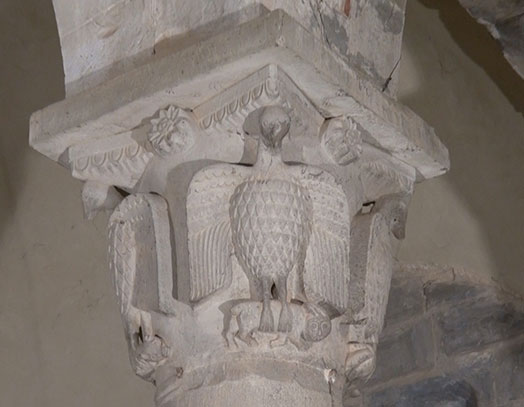THE CAPITAL of the EAGLES
right nave, fifth column
Here, too, the figures are on the four corners: four large eagles with their wings spread to appear in flight grasp their prey in their claws. The surface behind them is smooth, so that the abacus stands out, formed by rows of ovals, each row having a large flower coming out of leaves at its mid-point.
In Romanesque architecture the eagle was a very common decorative element as well as a symbol. In classical antiquity it was a psychopomp, a creature, often a bird, that accompanied souls into Hades. It continued to have this meaning in the Romanesque era, while at the same time being considered the king of birds and therefore often compared to Christ. Even more commonly, however, was it seen as the destructive predator that seizes souls. In fact the eagle, like the lion, is a symbolically ambivalent animal, varying according to the context in wich it is represented. In the capital here in Gropina the four eagles have captured small animals: a hare or rabbit and three large rodents, which, unlike the prey on the following capital, do not fight back against the rapacious birds, seeming almost resigned to their fate. The rabbit or hare stares at the observer with wide-open eyes, as if questioning, or perhaps giving a warning, because in Christian iconography these small animals also incarnate lustfulness: the eagle, as psychopomp, guides the souls of the sinner to eternal damnation, a terrifying theme for men of the middle ages filled with apocalyptic fears.
But as often happens in Romanesque art, there can be another, opposite, interpretation: the defenseless nature of the hare, for Christianity, symbolizes those who place their faith in Christ. Therefore in this case the eagle becomes good, not taking the soul of a sinner but a just soul to a happy afterlife, the Christian Paradise. The three rodents, mice or rats, are nevertheless always symbols of evil: the mouse devours the roots of the tree of life. Thus the column can be read in two ways, the second of which offering the medieval man the hope that not all is lost, that a soul can also be saved.
Stylistically, the capital is to be assigned to a local stone-cutter, and enriches the iconographic panorama of the Pieve di Gropina, a great architectural and sculptural monument, designated as a national monument for its historical-artistic importance.

